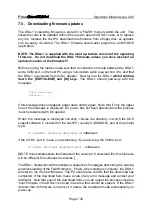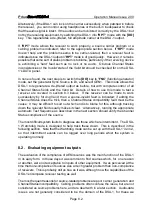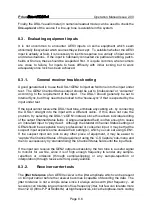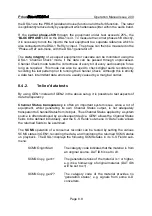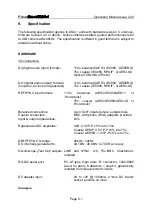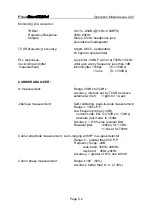
Prism
Operation Manual Issue 2.00
Page 8.6
Finally, the DSA-1's audio meter (in numerical readout mode) can be used to check the
line-up level of the source if a line-up tone is available in the system.
8.3. Evaluating equipment inputs
It is not uncommon to encounter AES3 inputs on some equipment which seem
abnormally fussy about which sources they will accept. To establish whether the AES3
input is actually at fault, it is necessary to test its response to a variety of input carrier
and data situations. If the input is habitually connected via particular cabling, patch-
fields or Krones, these should be suspected first. It is quite common, where carriers
are close to failure, for inputs to have difficulty with initial locking but to work
adequately once lock has been achieved.
8.3.1.
General receiver trouble-shooting
A good general test is to use the DSA-1 GEN2 to inject an fs/4 tone into the input under
test. The GEN2 Channel Status output should be set to 'professional' or 'consumer'
according to the requirement of the input. The DSA-1 should generally be set to
Internal Sync, but it may need to be locked to the 'house-sync' if that is expected by the
input under test.
If the input cannot receive the DSA-1 test tone, eliminate any cabling etc. by connecting
the DSA-1 straight into the input with a different cable. If this does not cure the
problem, try selecting the DSA-1's GEN1 instead, since this allows individual editing
of the output Channel Status fields. A single unexpected field is often enough to cause
an intolerant input to 'play dead'. Although the standard Channel Status settings of
GEN2 should be acceptable to any professional or consumer input, it may be that the
suspect input expects some unusual field setting(s), which you can set using GEN1.
If the suspect input can lock to any other piece of equipment, it may be easier to
'capture' the Channel Status of that equipment using the 'C-S Capture' sub-menu and
then to successively try 'standardising' the Channel Status fields until the input fails.
If the input can receive the GEN2 output successfully, the fs/4 tone is a useful signal
to monitor for a while, since it is of high enough frequency to render any sample-
repetition or omission (through sample-slipping) or any sample-repetition or
interpolation (through received errors) easily audible.
8.3.2.
Receiver carrier tests
The jitter tolerance of an AES3 receiver is the jitter amplitude which can be present
on its input carrier before the receiver becomes incapable of decoding the data. The
jitter tolerance is not a simple value since it always varies with jitter frequency - all
receivers can tolerate large amounts of low-frequency jitter, but few can tolerate more
than 1/2 UI (80ns P-P at fs=48kHz) at high frequencies, since the biphase-mark coding








